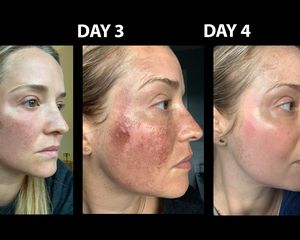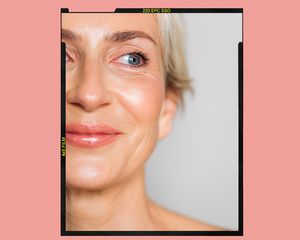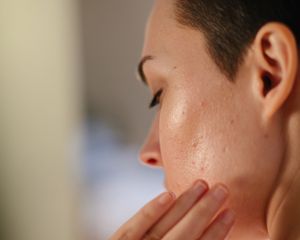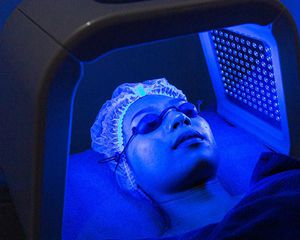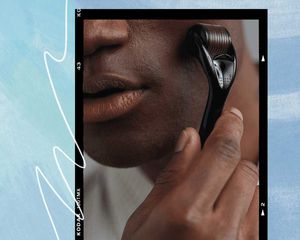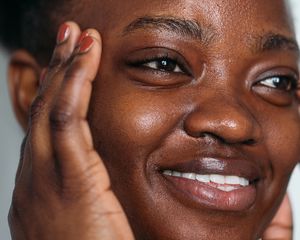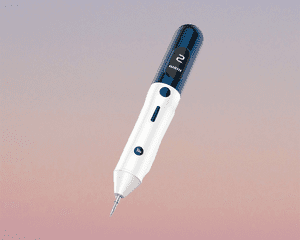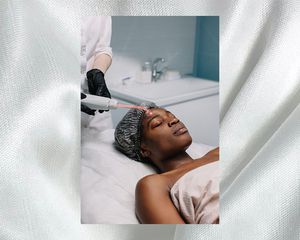
Getty Images/Unsplash
What if we told you that there’s a treatment out there that can get rid of your hard-to-treat dark spots, your stubborn pimples that keep coming back no matter how hard you try, or your unwanted moles and other bumps? Sure, you’d agree with us—there are tons. But what if we also told you that said treatment can be done in less than 15 minutes and requires virtually zero downtime? Plus, there’s no invasive peeling, no avoiding sunlight for days, and you can go straight back to the gym after treatment. And the best part? The results can last for up to a year or longer.
You’d probably think we were describing some sort of unicorn technology, something that clearly a fairy godmother dreamed up for us. But we’re here to tell you that this treatment does indeed exist—it’s called Cell-FX and it’s the baddie on the block. To get all the details, we consulted dermatologists and a plastic surgeon. Keep reading to learn all about Cell-FX treatment, so you can decide whether it's right for you.
Meet the Expert
- Dr. Bruce Katz, MD, is a board-certified dermatologist with over 30 years of experience. He is the director of New York City's Juva Skin & Laser Center, as well as a clinical professor of dermatology at the Icahn School of Medicine at Mount Sinai.
- Dr. Anna Guanche, MD, is a board-certified dermatologist and dermatologic surgeon who specializes in cosmetic procedures that minimize downtime and maximize results. She is the founder of Bella Skin Institute in Calabasas, California.
- Dr. Alexis Parcells, MD, is a board-certified plastic surgeon based in New Jersey and New York City. Passionate about women's empowerment, she takes an individualized approach in working with clients at her eponymous practice and also is the founder of skincare brand Sunnie.
What Is Cell-FX?
Cell-FX is a state-of-the-art device used to treat lesions (a.k.a. bumps and spots, including pimples, warts, moles, and enlarged sebaceous glands). How does it differ from other technologies used to treat bumps? Well, according to board-certified dermatologist Dr. Bruce Katz, it’s a new type of energy. “It’s an entirely new energy source,” he explains. “It’s called nano-pulse stimulation. It’s a very high-powered, short electrical pulse. This is the first time it’s been used in medicine.” Board-certified dermatologist and dermatologic surgeon Dr. Anna Guanche adds, “Cell-FX is a device that helps to improve skin tone and texture and reduce surface growths. It is a nano-pulsed or fast-pulsed electrical device that introduces energy via microneedles.”
Another major distinction between Cell-FX and other lesion treatments is that it targets the bump or spot only, so you don’t have to worry about damaging the healthy skin surrounding it. “It creates what’s called a programmed cell death. It’s very targeted, so if you’re treating an acne lesion, it’s only touching the sebaceous gland,” Katz explains. “It doesn’t cause any collateral damage to the nearby tissues. And there’s no thermal effect and no heat so there isn’t any damage to collagen or blood vessels. It just targets whatever cell you’re aiming at.”
And the best part? You don’t have to worry about these lesions growing back after treatment. “New cells regenerate and renew, for a natural, healthy appearance,” Dr. Alexis Parcells, board-certified plastic surgeon and founder of skincare brand Sunnie, tells us.
Benefits of Cell-FX
Cell-FX is truly changing the game when it comes to treating and removing unwanted lesions, as it has several benefits that stand out from other treatment options. A few main pros are as follows:
- Can help keep acne clear for up to a year
- Zero to minimal side effects
- Increases cell turnover
- Can effectively remove warts in just one to two treatments
- Reduces the appearance of dark spots and hyperpigmentation
- Treats moles and enlarged sebaceous glands
- Minimizes risk of scarring
- Quick treatment
Some of the most notable benefits of Cell-FX are that there’s virtually zero downtime, minimal risk of scarring, and a significant decrease in the chance of your lesion reappearing.
“Prior to Cell-FX, most skin lesions were treated with chemical, heat, or freezing therapies. These current therapies are not exact in terms of treatment depth and damage to nearby tissue,” Parcells explains. “Additionally, scarring with these treatments may occur. Cell-FX is a cell-specific, non-thermal NPS technology that can precisely target tissue depth, sparing surrounding healthy tissue and decreasing the risk of scarring.”
How to Prepare for Cell-FX Treatment
Due to Cell-FX’s non-invasive technology, you don’t have to take any special precautions beforehand, though some providers may ask you to remove makeup prior to treating facial lesions. To be sure, though, it’s a good idea to ask about advised preparations beforehand. Parcells also recommends that you speak with your physician prior to treatment, as they may recommend you stop certain medications to reduce the risk of bleeding.
What to Expect During Cell-FX Treatment
Cell-FX is a relatively quick and painless experience—you could even get it done on your lunch break and be back in the office before the hour is up.
Before your treatment, your provider will inject you with a local anesthetic to numb the area. Then, using a laser gun, they will target the specific lesion you want treated. According to Katz, this gun has tiny needles that insert themselves into the lesion, and the provider will then fire the machine—one series of pulses lasts anywhere from 10 to 15 seconds. Your provider will repeat these steps until all of your lesions are treated. During the treatment, you can expect to feel slight pressure from the needle insertion. You may also experience some twitching and a very mild stinging sensation from the electrical pulses. Depending on the number of lesions being treated, the entire Cell-FX experience lasts anywhere from 10 to 15 minutes.
“You can see visible results within one treatment, however, you may need several to treat stubborn lesions. Lesions typically clear within 30-60 days,” Guanche explains. “As the lesion clears and new cells regenerate to form a new skin layer, the gradual return to normal skin appearance can take between 60-90 days.”
Potential Side Effects
One of the best things about Cell-FX is the minimal risk for side effects. “That’s the great thing about Cell-FX—because it’s so targeted, it doesn’t cause any side effects to the surrounding tissues. It’s only treating the exact spot you’re targeting,” Katz explains.
Guanche adds, “In clinical studies, no serious side effects have been reported. There may be mild swelling and redness post-procedure.”
The Cost
Cell-FX is a cash-pay treatment that’s typically not covered by insurance. There isn’t a specific cost, as it can vary based on your location, your provider, and how many lesions you want treated. If you’re interested in a treatment, consult with your provider for more information.
Aftercare
After your Cell-FX treatment, you might experience slight swelling and redness—and, potentially, bleeding—from the site where the tiny needles were injected. Dr. Katz recommends using a bland ointment like Aquaphor on the lesions treated by Cell-FX. Parcells adds, “Most patients are able to return to routine activities after treatment. An antibacterial ointment may be recommended with a Band-Aid to avoid infection. Follow any post-procedure instructions provided by the medical office.”
As your lesions start to heal, you might experience scabbing and crusting. It’s important to let your skin heal and not pick at the scabs; they’ll heal on their own.
Final Takeaway
If you’ve been looking for a non-invasive, quick, and relatively painless way to treat your dark spots, lumps, bumps, and acne, Cell-FX might be a great option for you. The results are long-lasting and can be visible in as little as one to two treatments, making this procedure ideal if you're looking to heal stubborn lesions in a targeted way that preserves healthy cells.




